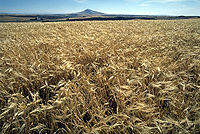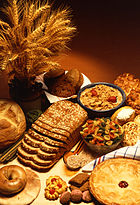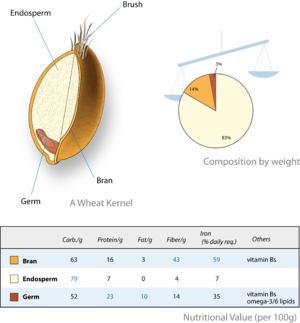- Bran
-
For other uses, see Bran (disambiguation).Not to be confused with chaff.
Bran is the hard outer layer of grain and consists of combined aleurone and pericarp. Along with germ, it is an integral part of whole grains, and is often produced as a by-product of milling in the production of refined grains. When bran is removed from grains, the grains lose a portion of their nutritional value. Bran is present in and may be milled from any cereal grain, including rice, corn (maize), wheat, oats, barley and millet. Bran should not be confused with chaff, which is coarser scaly material surrounding the grain, but not forming part of the grain itself.
Bran is particularly rich in dietary fiber and essential fatty acids and contains significant quantities of starch, protein, vitamins and dietary minerals.
Rice bran is a byproduct of the rice milling process (the conversion of brown rice to white rice), and it contains various antioxidants that impart beneficial effects on human health. A major rice bran fraction contains 12%-13% oil and highly unsaponifiable components (4.3%).[citation needed] This fraction contains tocotrienols (a form of vitamin E), gamma-oryzanol and beta-sitosterol; all these constituents may contribute to the lowering of the plasma levels of the various parameters of the lipid profile. Rice bran also contains a high level of dietary fibres (beta-glucan, pectin and gum). In addition, it also contains ferulic acid, which is also a component of the structure of nonlignified cell walls. However, some research suggests there are levels of inorganic arsenic (a toxin and carcinogen) present in rice bran. One study found the levels to be 20% higher than in drinking water.[1] Other types of bran (derived from wheat, oat or barley) contain less arsenic than rice bran, and are just as nutrient rich.[2]
The high oil content of bran makes it subject to rancidification, one of the reasons that it is often separated from the grain before storage or further processing. The bran itself can be heat-treated to increase its longevity.
Contents
Uses of bran
Bran is often used to enrich breads (notably muffins) and breakfast cereals, especially for the benefit of those wishing to increase their intake of dietary fiber. Bran may also be used for pickling (nukazuke) as in the tsukemono of Japan.
Rice bran, in particular, finds many uses in Japan, where it is known as nuka (糠; ぬか). Besides using it for pickling, Japanese people also add it to the water when boiling bamboo shoots, and use it for dish washing. In Kitakyushu City, it is called jinda and used for stewing fish, such as sardine.
In Myanmar, rice bran, called phwei-bya, is mixed with ash and used as a traditional detergent for washing dishes. Rice bran is also stuck to commercial ice blocks to hinder them from melting. It is also burned for fuel for rice mills in the rice growing regions of the Irrawaddy delta.
Use of rice bran as a food item is common among the people of the South Indian state of Kerala.
Rice bran and rice bran oil are widely used in Japan as a natural beauty treatment. The high levels of oleic acid makes it particularly well absorbed by human skin, and it contains over 100 known vitamins, minerals and antioxidants, including gamma oryzanol, which is believed to impact pigment development.
Bran oil may be also extracted for use by itself for industrial purposes (such as in the paint industry), or as a cooking oil, such as rice bran oil.
In Romania, the fermented wheat bran is usually used when preparing sour soups, called borscht.
Bran was found to be the most successful slug deterrent by BBC's TV programme, Gardeners' World.
It is a common substrate and food source used for feeder insects, such as mealworms and waxworms.
Bran for pets and livestock
Bran is widely used as a major component in foods for cattle, American bison, goats, rabbits, guinea pigs, etc.
Rice bran is sometimes fed to horses for its nutritional value, particularly as a plant-based fat supplement. It is considered an excellent way to put weight onto a thin horse, without the problems associated with overfeeding grain. Rice bran is also included in some foods for aging dogs.
Wheat bran is fed to horses in the form of a warm porridge or "mash". Bran mash is considered an excellent way to get the horse to drink more water. It is also indicated for its laxative qualities.
See also
References
- ^ "Inorganic Arsenic in Rice Bran and Its Products Are an Order of Magnitude Higher than in Bulk Grain - Environmental Science & Technology (ACS Publications)". Pubs.acs.org. 2008-08-21. http://pubs.acs.org/cgi-bin/abstract.cgi/esthag/asap/abs/es801238p.html. Retrieved 2010-02-09.
- ^ "Superfood rice bran contains arsenic - environment - 22 August 2008 - New Scientist". Environment.newscientist.com. http://environment.newscientist.com/channel/earth/dn14592-superfood-rice-bran-contains-arsenic.html?feedId=online-news_rss20. Retrieved 2010-02-09.
Barley resources History 
Types of barley Genus: Hordeum · Cultivars: BereAgronomy Trade Parts of the plant Basic preparations As an ingredient Barley bread · Barley honey · Beer · Caffé d'orzo · Irish whiskey · Japanese whisky · Malta · Roasted barley tea · Scotch whisky · Talbina · see also: Category:Barley-based beveragesAssociated human diseases Gluten sensitivity (Coeliac disease, etc.)Related concepts Further information Wheat resources History 
Types of wheat Agronomy Trade Australian Wheat Board · Canadian Wheat Board · Corn exchange · International Wheat Council · Peak wheat · Production statistics · Protein premium · Wheat poolParts of the plant Basic preparations None: Wheatberry · Milling: Farina · Flour (types) · Groats · Middlings · Semolina · Parboiling: BulgurAs an ingredient Associated human diseases Related concepts Further information Categories:- Cereals
- Food ingredients
Wikimedia Foundation. 2010.


